Things You'll Need
Screwdriver
5-quart slow cooker
1/4 cup dish soap
Water
Protective gloves
Handled scraper
Tweezers
Brass polishing agent
Toothbrush
Clean cotton rag
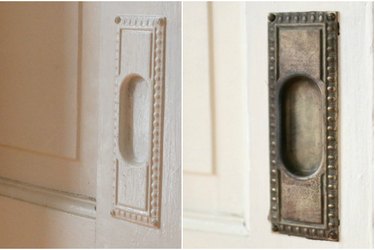
Metal door hardware, especially that which is found in older homes, can retain years of patina and may even be covered with several layers of paint. With the help of a slow cooker, water and dish soap, caked-on paint can be easily removed to restore the original details that give character to a home. This method works on all sorts of brass and metal hardware, from doorknobs to plates and hinges, locks and door knockers. When working with hardware that contains several layers of paint, there's a good chance it contains lead-based paint if the piece dates prior to 1980. It is important to use caution and wear protective gear, such as gloves and a face mask, when working around these materials to expose the paint.
Step 1
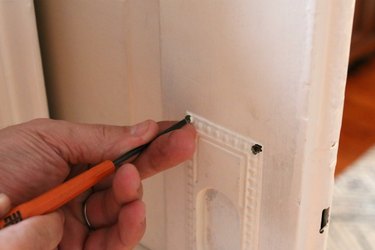
Remove the brass hardware from the door by first locating the screws and then gently scraping the paint around and in the centers to grip with a screwdriver.
Video of the Day
Step 2

If the hardware is stuck to the door after removing the screws, use the screwdriver to gently loosen and pry it away using one of the screw hole openings.
Step 3
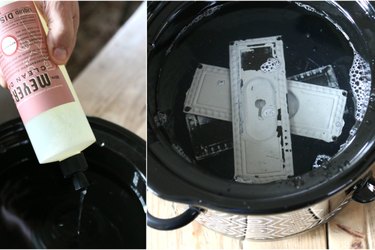
Drop the hardware into a slow cooker, adding water to cover the metal pieces by at least 1 inch. Add a healthy squeeze of dish soap (about 1/4 cup). Turn the cooker to the low-heat setting, cover with the lid and allow the metal pieces to soak for six to 10 hours or overnight.
The warmed water and soap work to slowly soften the paint, making it simple to peel away from the original brass metal pieces.
Step 4
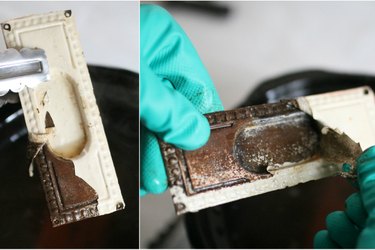
Turn off the slow cooker, put on protective gloves and carefully remove the metal hardware. The paint should lift and peel from the original piece with ease.
Step 5
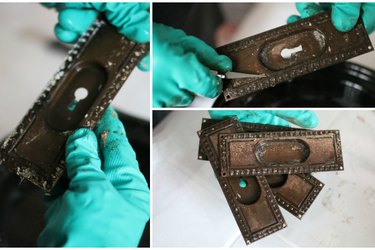
Rub any detailed crevices with a gloved hand and use tweezers to peel away any paint in smaller, tough-to-reach places.If small areas of paint remain, soak for another hour before peeling again.
Step 6

Rinse and dry the metal pieces. To dispose of water potentially contaminated with lead, first filter it through a cloth filter, like cheesecloth, before dumping into a sanitary sewer or toilet. For limited quantities of filtered debris, double-bag and dispose of it in the household trash.
If you're happy with the patina and aged look of the hardware, you're ready to reinstall the plates onto the door. For a more lustrous finish, use a brass polishing agent to bring out more of the original shine.
Step 7

Buff and polish the brass hardware until the finish shines to your liking.
Step 8

Carefully screw the cleaned hardware back in place on the door.
Video of the Day